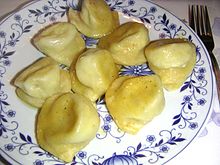Carinthian noodle
The Carinthian noodle (Carinthian Slovenian koroški krapi , plural ) is a thinly rolled out pasta dough that is shaped into a fist-sized bag and filled with various ingredients.
variants
Carinthian noodles are available with a wide variety of fillings, from savory to sweet, starting with “Kasnudel” (with a curd and potato filling, seasoned with mint and / or “Keferfil” ( chervil )) to meat noodle and potato noodle (with potatoes) Filling) and the “Herrnpilznudel” (with porcini mushroom filling) to the sweet apple noodles (apple and cinnamon filling) and Kletzennudeln (dried pears with curd cheese). The mint used for the classic “Kasnudel” filling is Mentha gentilis ( brown mint or noodle mint ), a hybrid of Mentha arvensis and Mentha spicata that occurs practically only as a cultivated plant .
"Curling"
The typical feature of this traditional noodle is the "curled" edge. As (waste) Krendeln or Gran punching the sealing is described by Pip-like compression of the Teigränder against superimposed. Significant for the importance attached to a beautifully curled edge in the past, the saying circulated in Carinthia : "A dirndl, that can not curl, you can get man". The traditional method of preparation is considered labor-intensive.
distribution
Carinthian noodles were mainly served on Friday, the day of the week without meat in Catholic tradition. Today Carinthian noodles are widespread in households and in the country's gastronomy, often in the form of industrially produced refrigerated food .
history
The oldest known written record comes from the year 1753 from Spittal an der Drau , but this does not prove the assumption that Upper Carinthia is the origin of Carinthian pasta. The expert in the Carinthian State Archives sees this as evidence that Upper Carinthia must be the origin of Carinthian pasta. Even the private secretary of the Udine Vicars of the Patriarch of Aquileia, Paolo Santonino, reported on his first trip through Upper Carinthia (travel diaries) of the “filled dough factories” of this region as early as 1485.
Similar pasta
The smaller Carinthian Schlickkrapfen , mostly with meat filling, and the Schlutzkrapfen from Tyrol , are similar to Carinthian noodles. In terms of size, shape and variety of fillings, they resemble the Polish “ Pierogi ruskie ” or “Piroschki” from Galicia or the vareniki of the Ukraine. Similar recipes for the production of filled pasta can also be found in other parts of Europe and also in Asia , for example in northern China .
literature
- Lia Miklau: Carinthian Kochbüchl. 6. Unchanged reprint. Klagenfurt, Verlag Johannes Heyn, 1984, 161 pages, ISBN 3-85366-202-1
Individual evidence
- ↑ http://members.chello.at/heinz.pohl/Sprachinseln.htm
- ↑ Carinthian noodles. By Martina Meuth and Bernd Neuner-Duttenhofer. In: WDR.de. August 10, 2019, accessed on August 12, 2019 (see video).
- ↑ Die Kärntner Nudel ( Memento of the original dated December 14, 2010 in the Internet Archive ) Info: The archive link was inserted automatically and has not yet been checked. Please check the original and archive link according to the instructions and then remove this notice. on teigtaschen.at, accessed on December 3, 2010
Web links
- Carinthian cheese noodles, Schlick- / Schlutzkrapfen . Entry no. 176 in the register of traditional foods of the Austrian Federal Ministry for Agriculture, Regions and Tourism .
- "Peasant food preparation - Carinthian noodles" (1968) - Ethnographic film from the collection of the Austrian Federal Institute for Scientific Film (ÖWF) in the online archive of the Austrian Media Library


